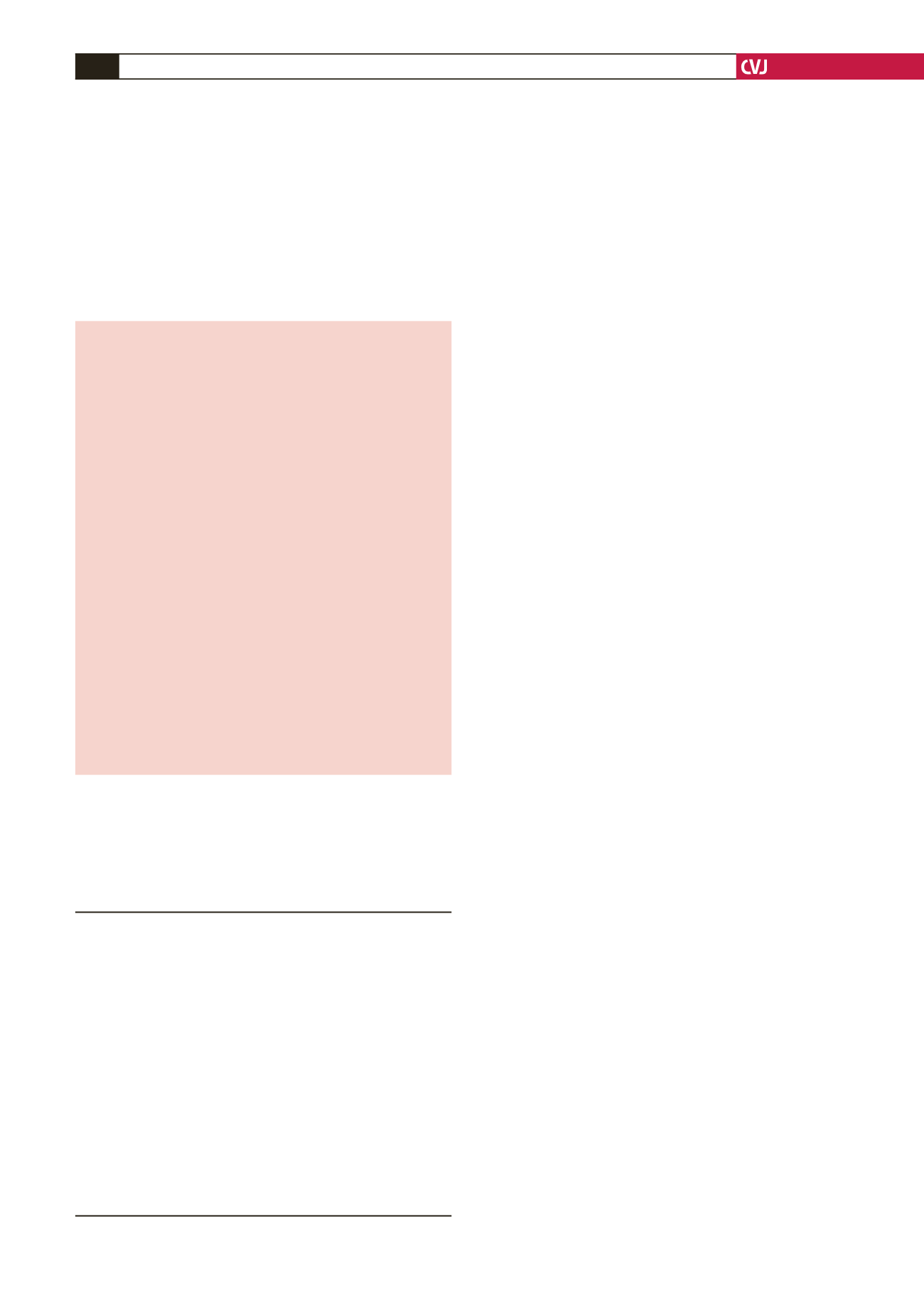

CARDIOVASCULAR JOURNAL OF AFRICA • Volume 28, No 3, May/June 2017
170
AFRICA
Training community health workers to screen for
cardiovascular disease risk in the community:
experiences from Cape Town, South Africa
Thandi Puoane, Shafika Abrahams-Gessel, Thomas A Gaziano, Naomi Levitt
Abstract
This article describes a training process to equip community
health workers (CHWs) with knowledge and skills to identify
individuals at high risk for cardiovascular disease (CVD) in a
township in Cape Town.
Methods:
CHWs were employed by a non-governmental
organisation (NGO) primarily focusing on non-communica-
ble diseases (NCDs). They were trained in the theory of CVD,
including physiological changes and related risk factors and
in obtaining anthropometric and blood pressure measure-
ments. Pre- and post-training tests assessed learning needs
and the effectiveness of imparting knowledge about CVD,
respectively.
Results:
Training increased knowledge about CVD risk
factors. CHWs were able to screen and identify those at risk
for CVD and refer them to health professionals for validation
of scores. The initial one-week training was too short, given
the amount of information covered. Some CHWs had diffi-
culty with English as the primary instruction medium and as
the only language in which tests were offered.
Conclusion:
Although CHWs could be trained to screen for
CVD risk, increased training time was required to impart
the knowledge. The language used during training and test-
ing presented challenges for those trainees whose dominant,
spoken language was not English.
Keywords:
community health workers, non-communicable
diseases, training, primary healthcare, cardiovascular diseases,
screening
Submitted 19/6/15, accepted 17/7/16
Cardiovasc J Afr
2017;
28
: 170–175
www.cvja.co.zaDOI: 10.5830/CVJA-2016-077
Community Health Workers (CHWs) are individuals who live
within the community they serve, understand the culture and
speak the language of the people who live around them. In many
low- and middle-income countries (LMIC), CHWs have been
used largely to manage infectious diseases.
In South Africa, CHWs were initially used to promote better
health in the communities during the 1980s. However, when the
democratically elected government came to power in 1994, its
plans to implement a national strategy for primary healthcare
did not include using the services provided by CHWs, because
it was claimed by the then minister of health that their services
provided ‘second rate’ healthcare.
1
As a result, the use of CHWs
declined, although this was reversed by the government when
the HIV epidemic placed increasing demands on the healthcare
system. Now that South Africa is faced with a rising burden of
non-communicable diseases (NCDs) in addition to injuries and
HIV/AIDs, it is essential that the country expand its focus to
include NCDs.
Indeed, in order to strengthen the current healthcare system,
the South African government committed to re-engineering the
primary healthcare system (PHC) as part of its strategic plan for
NCDs from 2012 to 2016.
2
It has undertaken to increase human
resource capacity by using CHWs in the management of chronic
conditions, with the goal of improving health outcomes.
The public health service provides care to about 80% of the
population and focuses primarily on management and control of
existing conditions and the prevention of complications among
individuals with current diseases. There has been no active
programme to provide early detection and management through
screening for those at risk for NCDs. A large percentage of the
population only visit a government health facility when they feel
pain, at which point the disease has typically progressed.
3
Based on the new public health approach,
4
a more holistic,
multidisciplinary and multi-sectorial approach is needed to
improve the health of the population by tackling risk factors
at the individual, community and societal levels. It is therefore
important to build the capacity of services delivered by CHWs
to include screening in the community, in order to identify
those at risk before progression of the disease, and to provide
appropriate referrals to health facilities for further assessment
and appropriate treatment.
Over the past two decades, CHWs have been successfully
used in HIV/AIDS programmes to provide palliative care
to infected people. In addition, they have played an active
School of Public Health, Faculty of Community and Health
Sciences, University of the Western Cape, South Africa
Thandi Puoane, DPhil,
tpuoane@uwc.ac.zaCenter for Health Decision Science, Harvard TH Chan
School of Public Health, Boston, MA, USA
Shafika Abrahams-Gessel, MSc, DPhil
Center for Health Decision Science, Harvard TH Chan
School of Public Health, Boston, MA, USA; Chronic
Disease Initiative for Africa, Division of Endocrinology
and Diabetes, Department of Medicine, University of Cape
Town, South Africa
Thomas A Gaziano, MD, MSc
Chronic Disease Initiative for Africa, Division of
Endocrinology and Diabetes, Department of Medicine,
University of Cape Town, South Africa
Naomi Levitt, MD, PhD

















